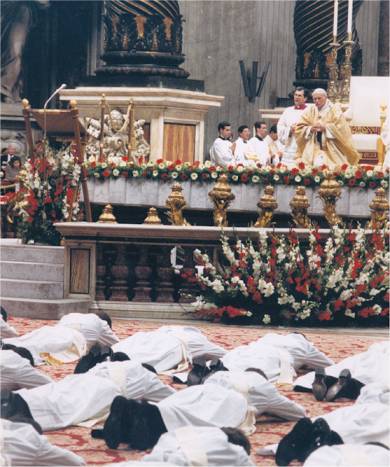My newest article in the Catholic Telegraph, which hits the mailboxes today:
As winter fades and spring starts to melt into summer, there are a great many events to celebrate in our local Church; first among these is the great celebration of our Salvation won by Christ in the mystery of Holy Week and Easter. With this celebration, we welcomed nearly 1,200 new converts into the fold of the Catholic Church, just here in our Archdiocese. There is no greater celebration during the Church year.
However, there are two other great ceremonies that are celebrated this time of year which rival the beauty of the Easter Vigil, especially for me as a priest: Ordinations to the Diaconate and to the Priesthood, the Sacrament where men are configured to be more like Christ in service to His Bride, the Church. Like Baptism and Confirmation, Holy Orders is a non-repeatable sacrament: once you are ordained, you are a priest forever. However, it is also unique in that it is entered through a series of three steps, or levels. Hence the name Orders, for this Sacrament is the foundation for the structure of how Christ constructed His Church.
This break down is not accidental, but a purposeful orientation for the man who presents himself to the Church for priesthood. He does not begin his priesthood seated on a throne in glory, rather his ordained life begins with service as a deacon. The very word means “servant” in Greek. For some, this is a permanent state, the Permanent Diaconate. The men ordained to this level live a life marked in service to God and to the parish they are assigned, the world in which they live and the marketplace where they work. Having worked with a few of these men, they are great assets and aids to the pastor. For men who are on the way towards priesthood, transitional deacons, their participation in the Order of Deacon forms them in a life of service and of giving themselves completely for the life of the Church. It is a formation in the command of Christ: “No one has greater love than this, to lay down one’s life for one’s friends (Jn 15:13).”
The second order within ‘Holy Orders’ is the priesthood. The service that a man began in his life as a deacon models and shapes his life as a priest. No one is a priest for himself, rather he is oriented to love the people of God to whom he has been sent. A priest is a man for others. His mission is to help and lead his congregation (his family) to grow in holiness. Especially today, this cannot be imposed upon a parish; it must first be modeled by the priest himself, and then given to his people. At his ordination, a priest is commissioned to imitate the Sacraments that he celebrates, so that he too can be a living Icon present in the world – a Living Icon of the Eternal Priesthood of Jesus Christ.
Finally, a select few are admitted to the third and final Order within the Church’s structure: Episcopacy, the Order of Bishops. This order is the fullness of the priesthood within the Church, and all priests exercise their ministry in unity with their bishop. It is the bishop who exercises his priestly role in leadership, unifying the diocese under his care, being a steward of the treasures of the diocese so that the Gospel can be preached in all of its wonder. The Order of Bishops is the direct descendant of the Apostles, through the Laying on of Hands. We find testimony to this even as far back as the early Second Century in the writings of St. Ignatius of Antioch, who states: “You must all follow the bishop as Jesus Christ follows the Father.”
As the two celebrations of ordination approach, it is important to keep in mind that no man is ordained for himself, rather he becomes the bridegroom – the Alter Christus, and he gives his life to the Church, his bride, just as all husbands are called to love their wives like Christ loves the Church: unto death. A man does this as a priest so that we may all have access to the Sacraments and may all attain the salvation won for us by Christ.
Thursday, April 19, 2007
Subscribe to:
Post Comments (Atom)










2 comments:
Gave your essay a plug over at the "Friends of CE" blog.
Thanks, Rich.
Post a Comment